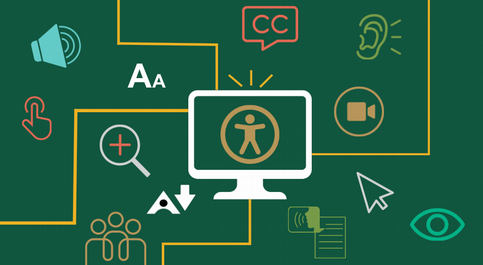William & Mary's Commitment to Digital Accessibility
Today, on Global Accessibility Awareness Day (GAAD), William & Mary is proud to unveil its latest initiatives aimed at enhancing digital accessibility for all members of its community. By implementing cutting-edge accessibility features that support visual, hearing, motor and cognitive impairments, the university is ensuring usability of its digital platforms and demonstrating leading efforts in accessibility among educational institutions.
“[Digital accessibility] aligns with Vision 2026, W&M’s strategic plan, in which the university strives to lead the nation in creating more equitable learning environments and workspaces and optimizing places and systems for operational excellence,” said Carla Costello, ADA/Section 504 Coordinator, “As the demand for online classes and other services continues to increase, we must include digital accessibility in the forefront of our planning.”
This proactive approach aligns with the recent digital accessibility regulation issued by the Department of Justice under Title II of the Americans with Disabilities Act (ADA). The rule established the Web Accessibility Guidelines (WCAG) Level 2.1 AA as the standard for digital accessibility, requiring state and local governments to meet these guidelines by April 2026. Moreover, it is paramount to W&M’s vision and core values to ensure communication is equally effective for individuals with and without disabilities.
W&M advanced the initiative by forming the Title II Digital Content Working Groups, consisting of leaders from various university departments. These groups include representatives from University Communications, Web & Design, Teaching & Learning, Administrative Systems, Information Technology and Procurement. Created by Chief Information Officer Ed Aractingi and Costello, these groups oversee their teams’ progress, achieving significant milestones on meeting the university’s digital accessibility policy. This ensures that all digital materials are accessible, benefiting students, faculty and staff.
A fundamental cornerstone of these initiatives is the launch of the new Digital Accessibility website, a comprehensive resource hub that supports the entire university community. Providing additional resources for online support is crucial to ensure information can be accessed without barriers, especially in an ever-increasing digital landscape. This knowledge base equips faculty and staff with guides for creating accessible digital content across various platforms and formats, including websites and social media, and offers innovative tools that identify and fix accessibility issues.
To further bolster these efforts, Costello and Aractingi advocated for the creation of a new position dedicated to ensuring the university’s digital content is accessible to all. Filza Khan, W&M’s inaugural digital accessibility specialist, entered this new role within Information Technology this January and, fueled by her compassionate interest in supporting individuals with disabilities, has already made remarkable strides. Originally from Pakistan, Khan says conversations about accessibility weren’t a focus where she grew up. “I always felt drawn to advocate for those who didn’t have access to the same opportunities as those who didn’t have barriers,” said Khan.
 After previously working in Disability Support Services at Knox College and witnessing the positive improvements that resulted from supporting students with disabilities, she knew this was the field for her. The opportunity to transition to digital accessibility is what drew her to the role because it was still a new concept for many in academic spaces.
After previously working in Disability Support Services at Knox College and witnessing the positive improvements that resulted from supporting students with disabilities, she knew this was the field for her. The opportunity to transition to digital accessibility is what drew her to the role because it was still a new concept for many in academic spaces.
“People often take our ease of access to technology for granted without realizing the difficulties individuals with disabilities often face,” Khan added. “Assistive technology such as closed captions on videos and meetings, text-to-speech screen readers, and alternative text on websites and social media, are a couple of examples that highlight the opportunities for digital accessibility.”
One of the most rewarding parts of her job is paving the way for future accessibility, whether that be through developing effective processes with procurement and vendors to ensure that purchased software has accessibility features, or through collaborating with other departments to ensure their materials follow the accessibility standards. Consistent communication with campus partners is key for fostering collaboration, as they play a significant role in reaching the goal of a digitally accessible campus for all.
Examples of some of the assistive technology software that follow these standards for digital content include, note-taking and audio recording, dictation for speech to text, screen readers, Blackboard Ally to ensure courses are accessible to all, Panopto for pre-recorded video captioning, and live-captioning on meetings. Additionally, we request all software vendors provide accessibility documention as part of the process of purchase approval.
As the university continues to champion digital accessibility, W&M is setting a powerful example for institutions worldwide. By meeting the legal requirements and implementing beneficial changes across digital materials, W&M ensures its unwavering commitment to belonging, curiosity, excellence, flourishing, integrity, respect and service. These initiatives not only enhance the digital experience for our current and prospective community but also reflect the university’s vision of a more accessible and inclusive future.



